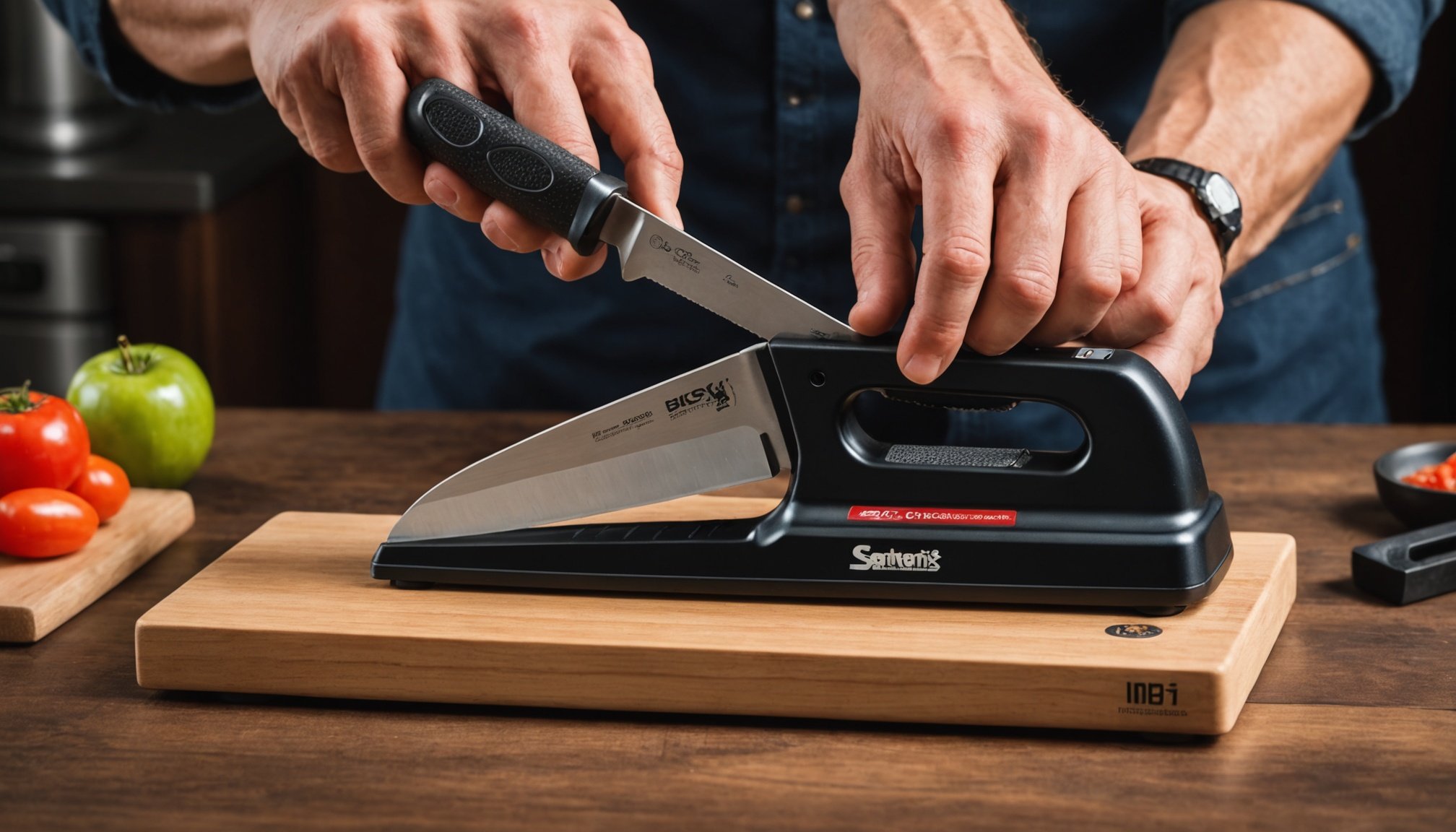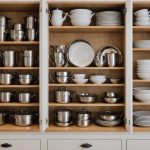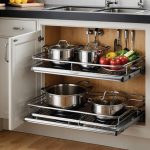Understanding the Unique Needs of Japanese Knives
To maintain the delicate edge of Japanese knives, selecting the correct sharpener is vital. The sharpening of Japanese knives involves distinct techniques compared to Western counterparts due to their unique construction and purpose. Japanese knives often possess a harder steel and a finer edge, necessitating precise maintenance.
Ceramic knife sharpening is an excellent choice for maintaining these knives because ceramic sharpeners require gentle usage, perfectly aligning with the thin, sharp edges of Japanese blades. This method allows for a more refined finish without compromising the blade’s integrity.
This might interest you : Egg separation simplified: essential tools for perfectly intact yolks every time!
Differentiating between Japanese and Western knife sharpening techniques is crucial. Western knives are typically crafted for robustness and are sharpened to a more obtuse angle. In contrast, Japanese knives have a more acute angle, leading to a sharper yet more delicate point.
Japanese knives often display common characteristics such as single-bevel designs and lighter weights, optimising them for specific culinary tasks. By understanding these unique features and applying appropriate knife maintenance, enthusiasts can preserve the performance and longevity of their Japanese cutlery.
Have you seen this : How can a blender be utilized creatively for both drinks and meals?
Always choose sharpeners that cater specifically to these specifications to ensure durability and optimal results. Knife maintenance, when tailored correctly, enhances both the experience and outcome of using Japanese kitchen knives.
Types of Ceramic Knife Sharpeners
Ceramic knife sharpeners come in two main types: manual and electric. The choice between these often depends on user preference and skill level.
Manual vs. Electric Sharpeners
Manual sharpeners give more control over the sharpening process, which can be beneficial for precision but might require a bit of practice. They tend to be more affordable and portable, making them a great choice for those comfortable working hands-on with their Japanese knives.
Electric sharpeners, however, provide convenience through automated sharpening. Although they can save time, they may not offer the same level of detailed precision as a manual approach. Their ease of use appeals to beginners, but they can be costlier and less portable.
Diamond vs. Ceramic Sharpeners
When considering diamond versus ceramic sharpeners, there are distinct differences. Diamond sharpeners are known for their ability to handle harder metals and offer quicker results. However, ceramic sharpeners are praised for their gentler approach, which is ideal for maintaining the delicate edge of Japanese knives. The durability and maintenance of these tools vary, with ceramic options typically requiring less frequent removal of material from the blade. Users should weigh these factors carefully to select the appropriate sharpening tool.
Pros and Cons of Ceramic Knife Sharpeners
Benefits of Ceramic Sharpeners have garnered attention among culinary enthusiasts, particularly for Japanese knives. These sharpeners excel in edge retention, making them ideal for maintaining the delicate edge required in these specialised tools. Their gentle approach ensures minimal wear on the blades, preserving their finer, sharper bevel longer than more abrasive alternatives.
However, drawbacks must also be acknowledged. Ceramic sharpeners, while excellent for maintaining an edge, may not be as effective for heavy-duty sharpening tasks. They can struggle to restore a heavily dulled or damaged knife, as more aggressive sharpening tools are better suited for such jobs.
User Recommendations highlight that ceramic sharpeners are best for regular maintenance rather than intensive repair. Many users advocate for their use due to their precision and alignment with the characteristic needs of Japanese knives. However, they caution that users should not rely solely on ceramic sharpeners if their knives require extensive reshaping.
By weighing these pros and cons, individuals can make informed decisions on whether ceramic options meet their maintenance expectations, effectively extending the life of their prized Japanese blades.
Step-by-Step Guide to Sharpening Japanese Knives
Transforming the process of maintaining Japanese knives into a routine task not only enhances performance but also extends the blade’s lifespan. By using proper sharpening techniques, users can achieve near-perfect precision.
Preparation and Setup: Before beginning, ensure your workspace is clean and well-lit. Gather all essential tools, including your ceramic sharpener and a damp cloth for stabilising the tool and keeping debris away.
Using a Ceramic Sharpener:
- Hold the knife securely at the correct angle (commonly around 15 degrees for Japanese blades) against the sharpener.
- Gently slide the edge across the ceramic surface, maintaining consistent pressure.
- Repeat the motion several times, focusing on evenness across the blade’s length.
Post-Sharpening Care: After achieving the desired sharpness, apply a light coat of oil. This prevents rust and keeps the blade in optimal condition. Storing the knife safely, away from other utensils, preserves its edge.
By following these steps, your Japanese knives will maintain their precise cuts. Regular knife care, paired with the right sharpening approach, ensures both durability and superior culinary experiences. Remember, consistent practice hones not just the blade, but the user’s adeptness as well.
User Reviews and Comparisons
Gathering insights from user feedback can significantly aid in making an informed decision when selecting a ceramic knife sharpener. Such reviews provide valuable firsthand experiences regarding product performance and user satisfaction.
Popular Ceramic Knife Sharpeners Reviewed
Through analysis, several ceramic sharpeners have received top ratings from consumers. Popular options often highlight features such as precision in edge retention and ease of use. The pros of these products typically include their gentle yet effective sharpening ability, catering well to the delicate blade of a Japanese knife. However, some users report drawbacks like the need for a specific skill level for optimal results or limited durability under frequent heavy usage.
Comparative Analysis of Leading Brands
When assessing brands, distinct differences emerge in terms of quality and pricing. Some brands are renowned for their innovative technology that offers reliable performance, whereas others may excel in providing budget-friendly options without sacrificing much on quality. Brand reputation further influences consumer confidence, ensuring better post-purchase support. Users often recommend brands that align with their specific skill set and sharpening needs, showcasing how initial investment in a reputable brand can pay off in terms of both utility and longevity.
Key Features to Consider When Choosing a Sharpener
Selecting the right sharpener for your Japanese knives is crucial for effective knife maintenance. One of the primary considerations is the grit level, which determines the sharpener’s performance. A higher grit provides a finer finish, making it suitable for maintaining the delicate edges of Japanese blades. In contrast, a lower grit is more abrasive, suited for initial sharpening phases or repairing damaged knives.
Ergonomic design plays a vital role in ensuring ease of use. Sharpeners with comfortable grips and stability features reduce fatigue during use and enhance precision. Therefore, opting for tools that fit well in hand can significantly impact the sharpening experience.
Portability is another essential factor. Compact sharpeners are ideal for those with limited storage space or who prefer to carry their tools on the go. Foldable or detachable sharpeners offer convenient storage, making them popular choices among culinary enthusiasts.
By focusing on these attributes—grit levels, ergonomic design, and portability—users can find a sharpener that meets their sharpening criteria and ensures optimal results. Prioritising these features guarantees that the sharpeners align with the specific needs of ceramic knife sharpening, ultimately preserving the unique characteristics of Japanese kitchen knives.
FAQ Section
Navigating the essentials of ceramic knife sharpening often invites several questions from users. Let’s address some frequently asked queries to enhance your knife maintenance routine.
Q: Can ceramic sharpeners restore heavily dulled Japanese knives?
A: Ceramic sharpeners are ideal for regular maintenance but not for restoring extensively dulled knives. For more significant damage, a more abrasive tool is recommended to rebuild the edge before refining it with ceramic sharpening.
Q: How often should I sharpen my Japanese knives?
Regular sharpening with a ceramic tool is suggested based on use frequency and cutting habits. Generally, light home-use requires quarterly maintenance when paired with routine honing.
Q: What’s the difference between Japanese and Western knife sharpening angles?
Japanese knives typically have a more acute angle (around 15 degrees), providing a sharper edge. In contrast, Western knives boast a 20-degree angle, offering durability over precision.
Q: Is it necessary to oil Japanese knives after sharpening?
Yes, applying a thin coat of oil after sharpening prevents rust, particularly in high-carbon models, preserving the blade’s longevity. Always store knives in a dry location for added protection.
Understanding these aspects fosters improved care, maximising the efficiency and life of your Japanese kitchen knives.











